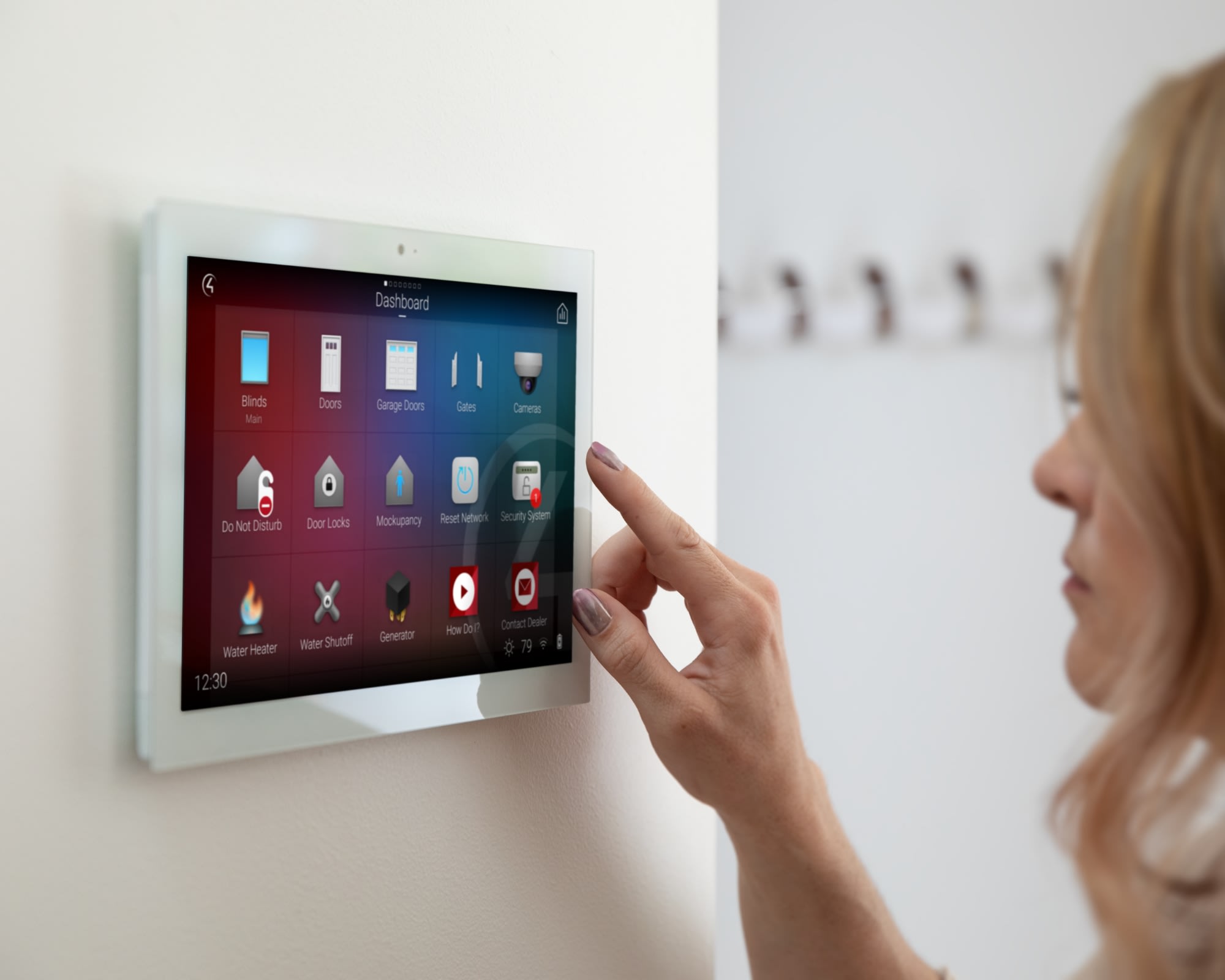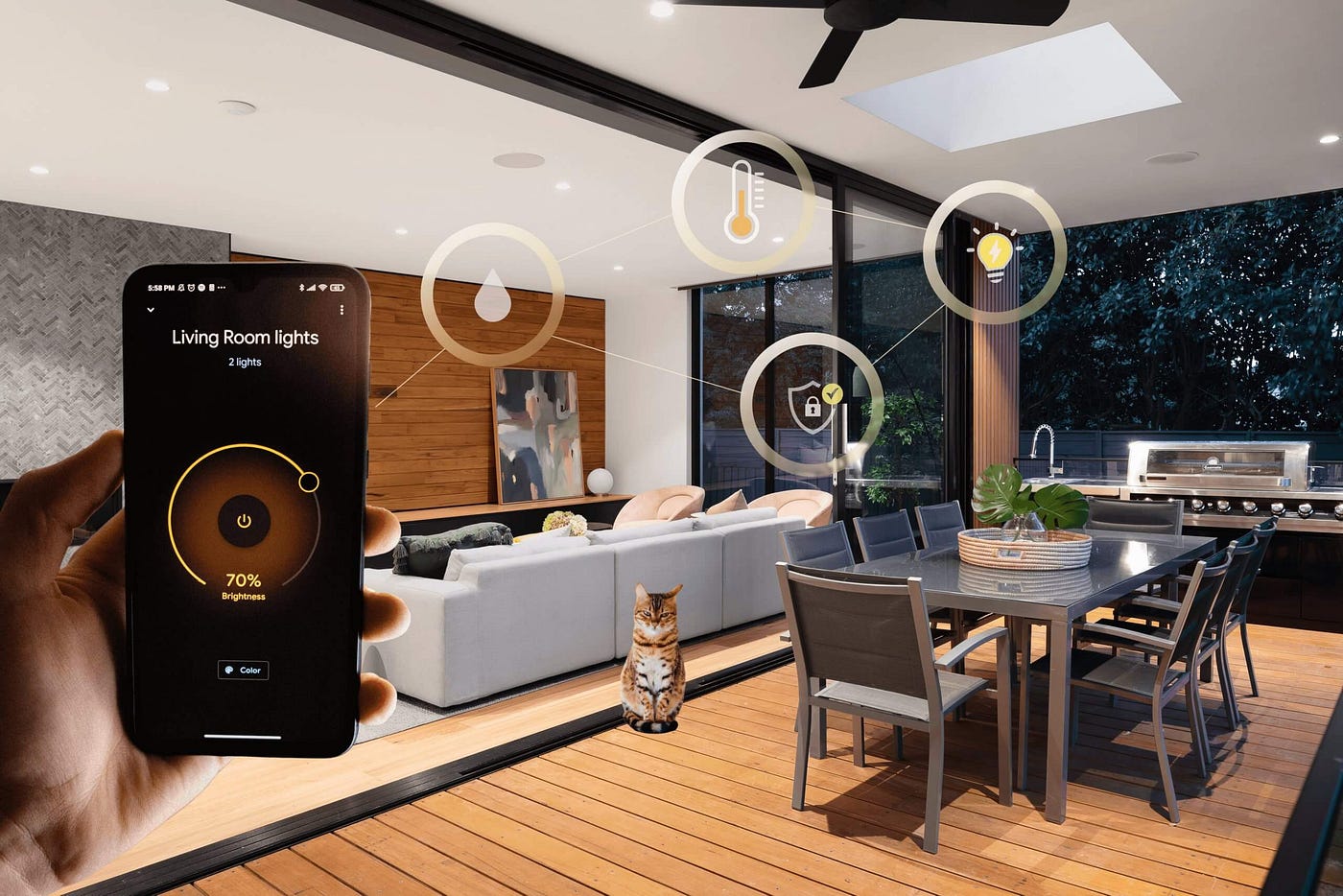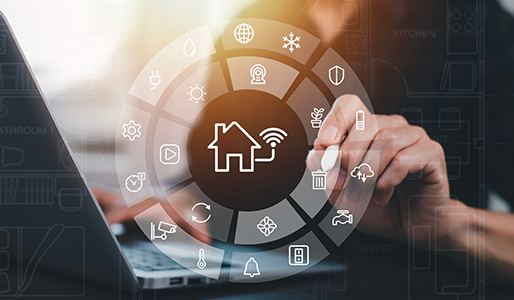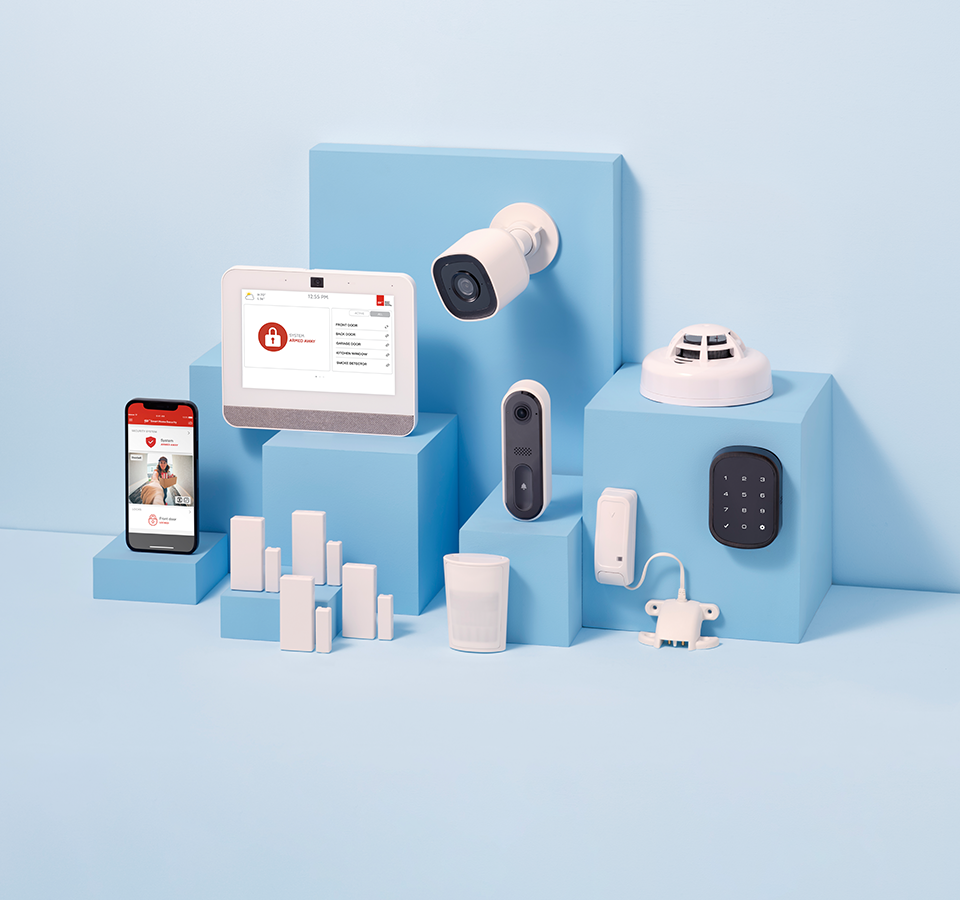Table of Contents

Article-at-a-Glance
-
Understanding the difference between smart devices and a smart home is key to choosing the right technology for your needs.
-
Smart devices are individual components that can be controlled remotely, while a smart home is a network of connected devices working together.
-
Setting up a smart home requires choosing an ecosystem, selecting a hub, and integrating devices for seamless operation.
-
Advanced smart home integration can provide convenience, energy savings, and enhanced security.
-
Contact us for personalized guidance on creating a smart home that fits your lifestyle.
When you’re standing in the electronics aisle, staring at a shelf full of gadgets that promise to transform your home, it’s easy to get overwhelmed. Let’s start by breaking down the basics. A smart device is like a solo artist – it can perform on its own and do some pretty impressive stuff. A smart home, on the other hand, is like an orchestra – a group of devices working in harmony to create something even more powerful.
What is the difference between a smart device and a smart home?
Let’s dig a little deeper. A smart device is a standalone gadget – think smart thermostats, lights, or security cameras. You can control these devices through an app or voice commands, and they can learn your habits to make your life easier. But when you link these devices together, they form a smart home. This network of devices can communicate with each other, creating an ecosystem that automates your home to respond to your needs without you having to lift a finger.
|
|
Smart Device |
Smart Home |
|---|---|---|
|
Definition |
A smart device is an individual electronic device that can be controlled remotely and has some level of intelligence or automation. |
A smart home is a residence equipped with multiple smart devices that work together to create a more convenient and efficient living environment. |
|
Examples |
Smartphone, smart thermostat, smart lock, smart light bulb |
Smart home system, smart lighting, smart security, smart entertainment |
|
Control |
Controlled individually by the user |
Controlled through a centralized system or via voice commands |
|
Integration |
Can be integrated with other smart devices, but not necessarily part of a larger system |
Part of a larger smart home system, allowing for seamless control and automation |
|
Installation |
Can be installed by the user or a professional |
Often requires professional installation for comprehensive smart home systems |
|
Cost |
Varies depending on the device, but generally less expensive than a smart home system |
More expensive than individual smart devices, but can save money on energy and other costs in the long run |
Core Components of Smart Devices
Most smart devices have a few things in common. They’re usually equipped with sensors, have some sort of connectivity (like Wi-Fi or Bluetooth), and can be controlled remotely. They might also have the ability to collect data to improve their performance over time. For instance, a smart thermostat can learn your schedule and adjust the temperature to save energy while you’re away.
Understanding Smart Home Ecosystems
When you’re ready to upgrade from a smart device to a smart home, you’ll need to understand ecosystems. An ecosystem is a family of products that can talk to each other and work together. The big players in this field are Google Home, Amazon Alexa, and Apple HomeKit. Choosing an ecosystem is like picking a team – once you’re in, all your devices need to play by the team’s rules. For more insights, check out this guide on smart home setup tips.

Streamlining Your Lifestyle with Smart Technology
Imagine waking up to the smell of coffee brewing, the shades gently rising to let in the morning light, and your favorite song playing softly in the background. This isn’t a scene from a sci-fi movie – it’s what a smart home can do for you. By integrating smart devices, you can streamline your lifestyle to enjoy these little luxuries every day.
The Convenience of Voice-Activated Assistance
Think of voice-activated assistants as your personal concierges. With a simple command, you can play music, order groceries, or get a weather update. They’re the glue that holds your smart home together, allowing you to control all your devices without lifting a finger. It’s like having a superpower – the power of convenience.
Saving Energy with Automated Home Systems
Besides the cool factor, smart homes are also about being eco-friendly. Automated systems can help you save on energy bills. Your smart thermostat can adjust the temperature when no one’s home, and smart lights can turn off automatically when you leave a room. It’s not just good for your wallet; it’s good for the planet, too.
Choosing the Right Smart Home Hub
First things first, to create a smart home, you need a brain to run the show. That’s where a smart home hub comes in. It’s the central command center that connects all your devices. Think of it as the maestro of the orchestra, making sure every instrument (or device) is in tune. But how do you choose the right one? Consider compatibility with your devices, the ecosystems it supports, and how user-friendly the interface is. Remember, this is the cornerstone of your smart home, so choose wisely!
Some popular hubs include the Amazon Echo, Google Nest Hub, and Apple HomePod. Each of these supports a range of devices and services, but they tend to play nicest with products within their own ecosystem. So, if you’re an iPhone user with a penchant for Siri, the Apple HomePod might be your go-to. On the flip side, if you’re all about Amazon Prime and love chatting with Alexa, an Amazon Echo could be your match.
Connecting Devices for Seamless Interaction
Once you’ve picked your hub, it’s time to start connecting devices. The goal here is seamless interaction. You want your smart lights, thermostat, security cameras, and speakers all talking to each other like old friends. To do this, you’ll need to make sure they’re all compatible with your chosen hub. Look for devices that mention they work with Google Assistant, Amazon Alexa, or Apple HomeKit, depending on your hub. Then, it’s as simple as following the setup instructions to get them connected.
Expanding Your Control with Advanced Integration Options
For those who want to take their smart home to the next level, advanced integration options are where it’s at. This might include setting up routines where multiple actions happen with a single command, or creating scenes that adjust several devices at once to set the mood. It’s like having a magic wand that readies your home for movie night or a dinner party with a single “abracadabra” (or, you know, “Hey Google”).
Incorporating IoT for a Fully Connected Home
The Internet of Things (IoT) is what happens when you not only connect devices within your home but also tap into a wider network. This could mean your fridge knows when you’re out of milk and adds it to your shopping list, or your washing machine starts a cycle when electricity rates are lowest. To get here, you’ll want to look for devices that support IoT protocols like Z-Wave or Zigbee, which help them communicate more effectively. For a more comprehensive understanding, consider exploring this smart home setup tips guide for details on moving and transferring your smart devices.
It’s like your home has its own social network, with devices chatting and making decisions to help your day run smoother. But remember, with great power comes great responsibility. Make sure your network is secure and your devices are from reputable brands that prioritize your privacy.
Enhanced Integration: When to Consider Professional Help
Now, if all this talk of hubs, IoT, and protocols is making your head spin, it might be time to consider professional help. There’s no shame in calling in the experts, especially when it comes to getting the most out of your smart home. They can help you navigate the complexities and set up a system that’s tailored to your lifestyle. And hey, if you want to get started, just Contact Us. We’re here to help you turn your home into the smartest one on the block.
-
Choose a hub that is compatible with your existing devices and preferred ecosystem.
-
Ensure seamless interaction between devices by checking for cross-compatibility and following setup instructions.
-
Consider advanced integration for routines and scenes to automate your home life further.
-
Look into IoT devices for a fully connected home that can make intelligent decisions on your behalf.
-
Seek professional help for enhanced integration if you feel overwhelmed by the setup process.
By now, you should have a good idea of what it takes to start your smart home journey. But what about taking full control of your home’s potential? Let’s dive into that next.

Empower Your Home: Unlocking the Potential of Smart Integration
Empowering your home with smart integration isn’t just about adding a few gadgets; it’s about creating a living space that adapts to your needs and simplifies your life. Customizing routines for your smart devices can ensure that your home responds to your daily patterns, from brewing coffee in the morning to dimming the lights at bedtime.
Managing your home remotely is another game-changer. Whether you’re at work or on vacation, you can check in on your home, adjust the thermostat, or even unlock the door for a friend. It’s the ultimate convenience and peace of mind, all at your fingertips.
And let’s not forget about security. A smart home can alert you to any unusual activity, record video footage, or even simulate occupancy to deter potential intruders. It’s like having a personal security guard who’s always on duty.
For example, imagine you’re running late for work. With a smart home, you can simply say, “Hey Siri, I’m leaving,” and your home will lock the doors, turn off the lights, adjust the thermostat, and activate the security system. It’s that easy.
Most importantly, remember that a smart home is what you make of it. It can be as simple or as complex as you want, but the goal is always to make your life easier and more enjoyable. So why not take the first step towards that future? If you need guidance or have questions, just Contact Us. We’re excited to help you unlock the full potential of your smart home.
Customizing routines in your smart home isn’t just about fancy tech; it’s about making your day-to-day life more efficient. Think about the things you do every day, like turning off all the lights before bed or adjusting the thermostat. Now imagine if all those things could happen on their own, at the exact time you usually do them, or even based on other triggers, like the sun setting. That’s the beauty of customized routines.
Customizing Routines for Maximum Efficiency
For example, you can create a ‘Good Morning’ routine that gradually turns on the lights, raises the temperature a bit, and maybe even starts brewing your coffee — all triggered by your alarm in the morning. Or a ‘Leaving Home’ routine that checks if all doors are locked, appliances turned off, and security system armed when you step out for work. It’s about creating a home that knows you and your preferences, almost as if it has a mind of its own.
And the best part? Setting up these routines is usually pretty straightforward. Most smart home apps provide a simple interface to select which actions you want to happen and when. It’s like setting an alarm, but instead of waking you up, it’s your home that springs into action.
Managing Your Home Remotely: The Ultimate Convenience
There’s a certain peace of mind that comes with being able to check in on your home no matter where you are. Left for vacation and can’t remember if you locked the back door? No problem, just pull out your phone and check. Want to adjust the temperature so it’s nice and cozy when you get back from a trip? A few taps, and it’s done. Managing your home remotely means you’re always just a few clicks away from ensuring everything is just the way you want it.
Whether you’re a parent wanting to keep an eye on things while the kids are home alone, or you’re someone who travels frequently for work, the ability to manage your home remotely is the ultimate convenience. And for those times when you’re not sure if you’ve left the oven on or the garage door open, being able to check and control these things remotely can be a real lifesaver.

FAQ
What are the most common smart devices for beginners?
If you’re just dipping your toes into the world of smart homes, there are a few devices that are great for starters. Smart bulbs, smart plugs, and smart thermostats are the go-to choices. They’re relatively affordable, easy to install, and offer immediate benefits like energy savings and convenience. Plus, they’re usually compatible with multiple ecosystems, so you can choose the one that works best for you.
Can different brand smart devices work together?
The short answer is yes, but it depends. Many smart devices now support common standards like Wi-Fi, Zigbee, or Z-Wave, which means they can often work together even if they’re from different brands. However, it’s crucial to check the compatibility of each device with your smart home ecosystem or hub before you buy. Some devices are designed to work specifically with certain platforms like Google Assistant, Amazon Alexa, or Apple HomeKit.
How secure is a smart home system?
Security is a big concern with smart homes, and rightfully so. But the good news is that as technology has advanced, so have the security measures. Most reputable smart home devices come with strong encryption and regular software updates to keep hackers at bay. It’s also important to use strong, unique passwords for your devices and Wi-Fi network, and consider a VPN if you’re accessing your smart home remotely.
What are the costs associated with upgrading to a smart home?
Costs can vary widely depending on the scale of your smart home ambitions. For a basic setup with a few smart bulbs and a smart plug, you might spend as little as $100 to $200. If you’re going for a full-blown smart home with multiple devices across different categories, the costs could run into the thousands. But remember, these are investments in your home’s efficiency, security, and convenience. Plus, many smart home devices can lead to savings on your energy bills, which can help offset the initial costs over time.



